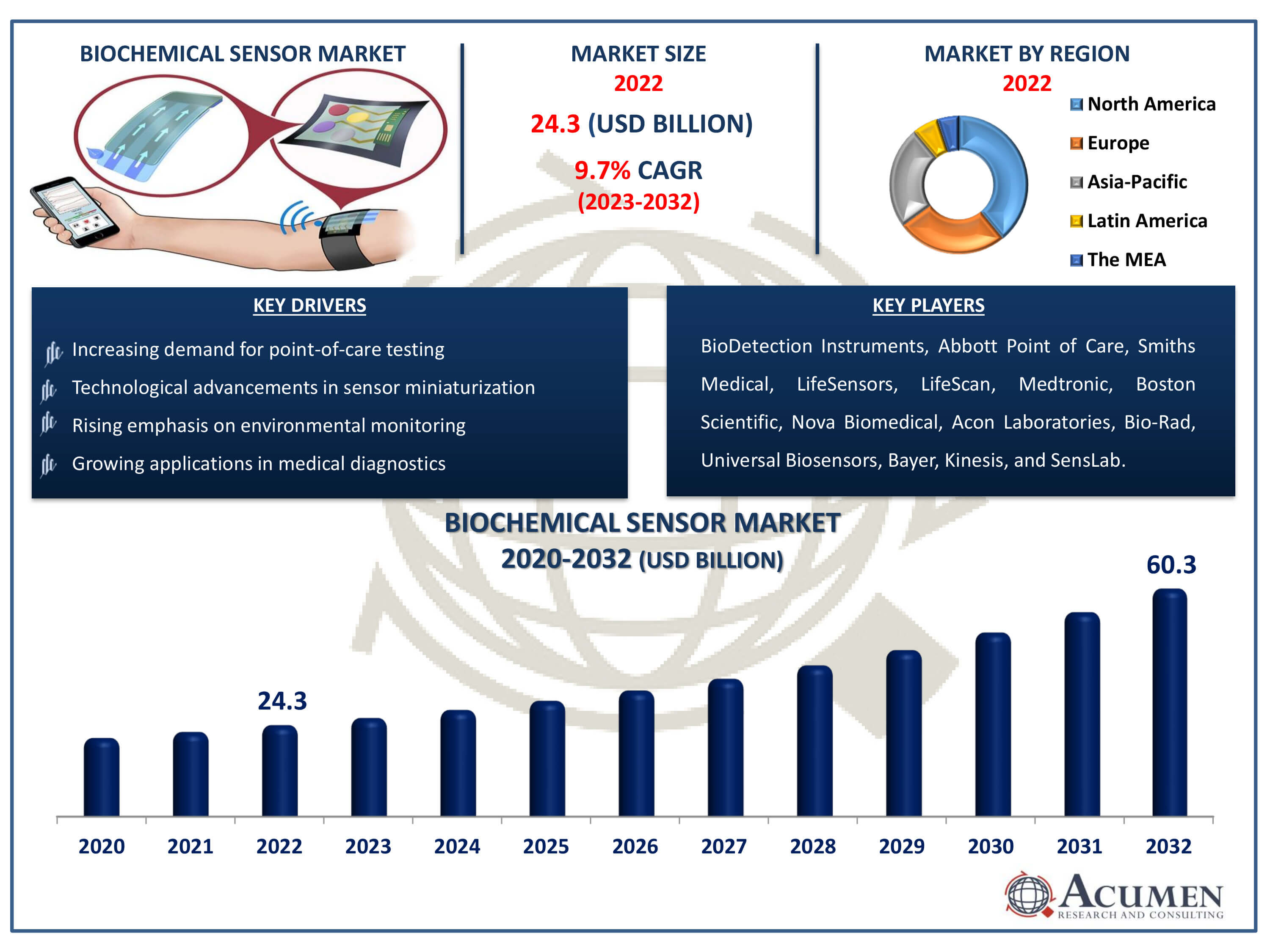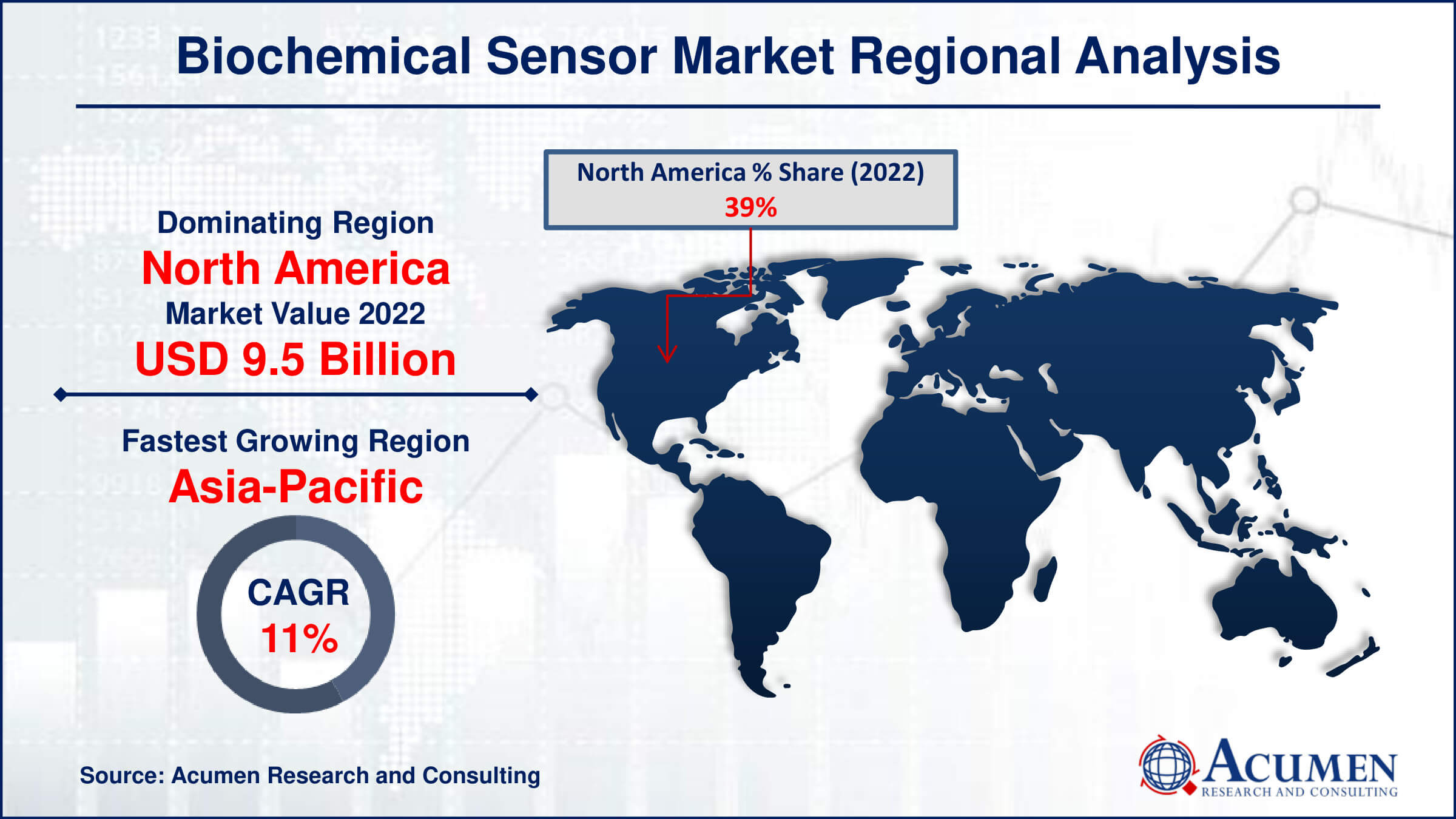November 2018
Biochemical Sensor Market Size accounted for USD 24.3 Billion in 2022 and is estimated to achieve a market size of USD 60.3 Billion by 2032 growing at a CAGR of 9.7% from 2023 to 2032.
The Biochemical Sensor Market Size accounted for USD 24.3 Billion in 2022 and is estimated to achieve a market size of USD 60.3 Billion by 2032 growing at a CAGR of 9.7% from 2023 to 2032.
Biochemical Sensor Market Highlights

Biochemical sensors transform biological or chemical samples into analytical or electrical signals using transducers. Their adaptability extends to a wide range of disciplines, including environmental monitoring, defence and safety measures, food quality assurance, and medical diagnosis. Government programs are progressively supporting the use of biochemical sensors in agricultural techniques to improve productivity and sustainability. Furthermore, these sensors are useful in clinical studies, providing precise data for research reasons and considerably contributing to the proper diagnosis of chronic diseases. Biochemical sensors continue to revolutionize numerous sectors, boosting innovation and enhancing general quality of life as sensor technology progress and applications increase.
Global Biochemical Sensor Market Dynamics
Market Drivers
Market Restraints
Market Opportunities
Biochemical Sensor Market Report Coverage
| Market | Biochemical Sensor Market |
| Biochemical Sensor Market Size 2022 | USD 24.3 Billion |
| Biochemical Sensor Market Forecast 2032 |
USD 60.3 Billion |
| Biochemical Sensor Market CAGR During 2023 - 2032 | 9.7% |
| Biochemical Sensor Market Analysis Period | 2020 - 2032 |
| Biochemical Sensor Market Base Year |
2022 |
| Biochemical Sensor Market Forecast Data | 2023 - 2032 |
| Segments Covered | By Product, By Film Deposition Material, By Application, And By Geography |
| Regional Scope | North America, Europe, Asia Pacific, Latin America, and Middle East & Africa |
| Key Companies Profiled | BioDetection Instruments, Abbott Point of Care, Smiths Medical, LifeSensors, LifeScan, Medtronic, Boston Scientific, Nova Biomedical, Acon Laboratories, Bio-Rad, Universal Biosensors, Bayer, Kinesis, and SensLab. |
| Report Coverage |
Market Trends, Drivers, Restraints, Competitive Analysis, Player Profiling, Covid-19 Analysis, Regulation Analysis |
Biochemical Sensor Market Insights
Several significant aspects contribute to the worldwide biochemical sensor market's growth. For starters, people all across the world are becoming more mindful of their health. This increased awareness raises the need for novel healthcare products, such as biochemical sensors, which play an important role in illness diagnosis and management. Second, the growing requirement for oil extraction, together with advances in sensor technology, drives higher demand for biochemical sensors in the oil and gas industry. These sensors help to monitor numerous factors during extraction procedures, which improves efficiency and safety.
Furthermore, the increasing number of motor vehicle accidents emphasises the significance of speedy and precise medical diagnoses, promoting the use of biochemical sensors in emergency medical services and trauma treatment. Additionally, improvements in material chemistry and wireless sensor networks help to the growth of the biochemical sensor market by enabling the creation of more sensitive, reliable, and cost-effective sensor technologies. Moreover, ongoing government activities focused at maintaining global food safety contribute to the growing trends in the biochemical sensor market. Regulatory assistance and financing stimulate the use of novel sensor technology for food quality monitoring and contamination detection.
Despite these drivers, several limitations may limit market expansion in the biochemical sensor market forecast period. The limited commercialization of biochemical sensors due to sophisticated product designs and issues with real-world application compatibility is a key impediment to industry development. Nonetheless, there are tremendous development chances ahead. Wearable biochemical sensors are increasingly being used in biosurveillance and defence, which represents a significant market growth opportunity. Wearable sensors provide continuous, real-time monitoring of biomarkers, allowing for early diagnosis of health concerns and improved situational awareness in defence applications.
Biochemical Sensor Market Segmentation
The worldwide market for biochemical sensor is split based on product, film deposition material, application, and geography.
Biochemical Sensor Products
According to biochemical sensor industry analysis, electrochemical sensors dominate the market due to their adaptability and broad range of applications.. These sensors provide precise detection and quantification of a variety of analytes by monitoring electrical characteristics changes caused by chemical reactions. Electrochemical sensors are essential instruments for real-time analysis and monitoring in a variety of applications, including healthcare, environmental monitoring, food safety, and industrial operations. Their capacity to detect a wide range of compounds, along with advances in nanotechnology and sensor miniaturisation, strengthens their market position. Furthermore, continuous research and development efforts continue to increase electrochemical sensors' sensitivity, selectivity, and durability, propelling their use in crucial industries and cementing their position as the biochemical sensor market's foundation.
Biochemical Sensor Film Deposition Materials
Silicon oxide (SiO2) is expected to lead the biochemical sensor market as the largest category due to its varied features and extensive application in sensor technology. SiO2 makes a good substrate material because to its great chemical stability, biocompatibility, and simplicity of deposition. These characteristics make it perfect for enabling sensor functionality and improving sensor performance. Furthermore, SiO2 films may be customised to have precise surface characteristics, allowing for the immobilisation of biomolecules and sensitive detection of target analytes. The intensive research and development efforts aimed at optimising SiO2-based sensor platforms strengthen its position as a favoured choice in the biochemical sensor industry, paving the way for future supremacy.
Biochemical Sensor Applications
In terms of biochemical sensor market analysis, the clinical diagnosis is anticipated to be the largest category due to a variety of factors. With rising healthcare costs and the incidence of chronic illnesses, there is a greater need for quick and precise diagnostic solutions. Biochemical sensors serve an important role in clinical settings because they enable the identification of biomarkers associated with various illnesses, allowing for early diagnosis and appropriate therapy. Furthermore, advances in sensor technology, such as miniaturisation and multiplexing capabilities, make them more useful in clinical diagnostics. Furthermore, continuous research and development activities aimed at broadening the uses of biochemical sensors in point-of-care testing and personalized medicine are driving their acceptance in clinical diagnostics, confirming this segment's predicted market leadership.
Biochemical Sensor Market Regional Outlook
North America
Europe
Asia-Pacific
Latin America
The Middle East & Africa

Biochemical Sensor Market Regional Analysis
The biochemical sensor market has varied dynamics across geographies, impacted by variables such as technical improvements, healthcare infrastructure, regulatory environment, and market demand. North America commands a sizable portion of the worldwide market, thanks to large R&D activity, a strong healthcare infrastructure, and high adoption rates of novel technology. Europe is closely following, benefiting from favorable government policies that encourage healthcare innovation and considerable investment in R&D.
Asia-Pacific develops as a profitable market this region is expected to grow fastest throughout the biochemical sensor industry forecast period, driven by fast industrialization, rising healthcare spending, and growing awareness of the value of early illness diagnosis. Furthermore, increasing activities for environmental monitoring and food safety standards are driving market expansion in the area. In Latin America, the Middle East, and Africa, the market is marked by increased healthcare investments, improved infrastructure, and a rising emphasis on disease prevention and control. Overall, regional research indicates a dynamic landscape with several prospects for market development, fueled by technical improvements, healthcare reforms, and altering consumer preferences across geographic areas.
Biochemical Sensor Market Players
Some of the top biochemical sensor companies offered in our report includes BioDetection Instruments, Abbott Point of Care, Smiths Medical, LifeSensors, LifeScan, Medtronic, Boston Scientific, Nova Biomedical, Acon Laboratories, Bio-Rad, Universal Biosensors, Bayer, Kinesis, and SensLab.
Looking for discounts, bulk pricing, or custom solutions? Contact us today at sales@acumenresearchandconsulting.com
November 2018
June 2024
June 2021
June 2020